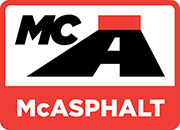Micro-Surfacing
Micro-surfacing is composed of engineered, polymer-modified asphalt emulsions mixed with crushed well-graded aggregate, mineral filler, water and additives. The main difference between this system and slurry systems is that micro-surfacing is stackable and therefore engineered for rut fill applications and minor structural deficiencies.
Design Criteria
When designing a micro-surfacing a number of factors have to be examined and assessed to ensure a proper surface will be placed that will perform for its service life. The following factors can have a tremendous effect on the performance of a micro-surfacing; traffic, aggregate, existing surface and compatibility. If these factors are addressed the chances of a good micro-surfacing being placed are greatly increased.
Traffic:
The type and quantity of traffic will have a large effect on the amount of asphalt emulsion to be used as well as the gradation of the aggregate to be used.
Aggregate:
The overall shape of the mix aggregate can influence the quantity of aggregate as well as the amount of asphalt emulsion to be used. The angularity of the aggregate will affect the performance of the finished mat. The aggregate should be 100% crushed and be both hard and high quality.
Existing surface:
The texture and condition of the existing road surface will affect the aggregate type, quantity and emulsion rate.
Compatibility:
The compatibility of the emulsion with the aggregate is critical to the finished mix and its performance.
If these factors are taken into consideration in designing the micro-surfacing then the chances of a successful mix are greatly improved. By blending all the materials in the proper proportions a semi-fluid , homogeneous mix will be produced.
Materials
Asphalt Emulsions:
The asphalt emulsion is a cationic quick setting polymer modified emulsion conforming to the CSS-1H type emulsion requirements as well as other tests performed on the emulsion residue.
Mix Aggregate:
The type of mix aggregate used in micro-surfacing must meet certain requirements of shape, size, cleanliness and gradation. The asphalt emulsion to be used and the aggregate must be compatible to ensure the asphalt-aggregate bond is effective. There are three accepted gradations for the aggregate to meet;
- Type 2 – most widely used gradation on moderate trafficked roads
- Type 3 – used on higher volume roads such as highways
- Type 3Mod – used by MTO for heavy trafficked roads
Further information on the gradations can be found in the Basic Asphalt Emulsion Manual.
Mineral Fillers:
Mineral fillers such as Portland cement orhydrated lime may be added to aid in stabilizing and setting the mix.
Water:
Water is used to aid in mixing and coating and controlling the consistency of the slurry seal. It should be potable and compatible with the mix.
Water is used to aid in mixing and coating and controlling the consistency of the micro-surfacing. It should be potable and compatible with the mix.
Performance Guidelines
In order to construct a proper well designed micro-surfacing the following guidelines should be followed:
- Design a micro-surfacing with aggregate to be used on job
- Use a hard durable screenings of high quality
- Ensure compatibility of aggregate and emulsion
- Ensure a homogeneous condition of the mix
- Calibrate and inspect all equipment
- Follow proper construction techniques
- Use traffic control to protect surfacing
- Work only in weather suitable for placing micro-surfacing
